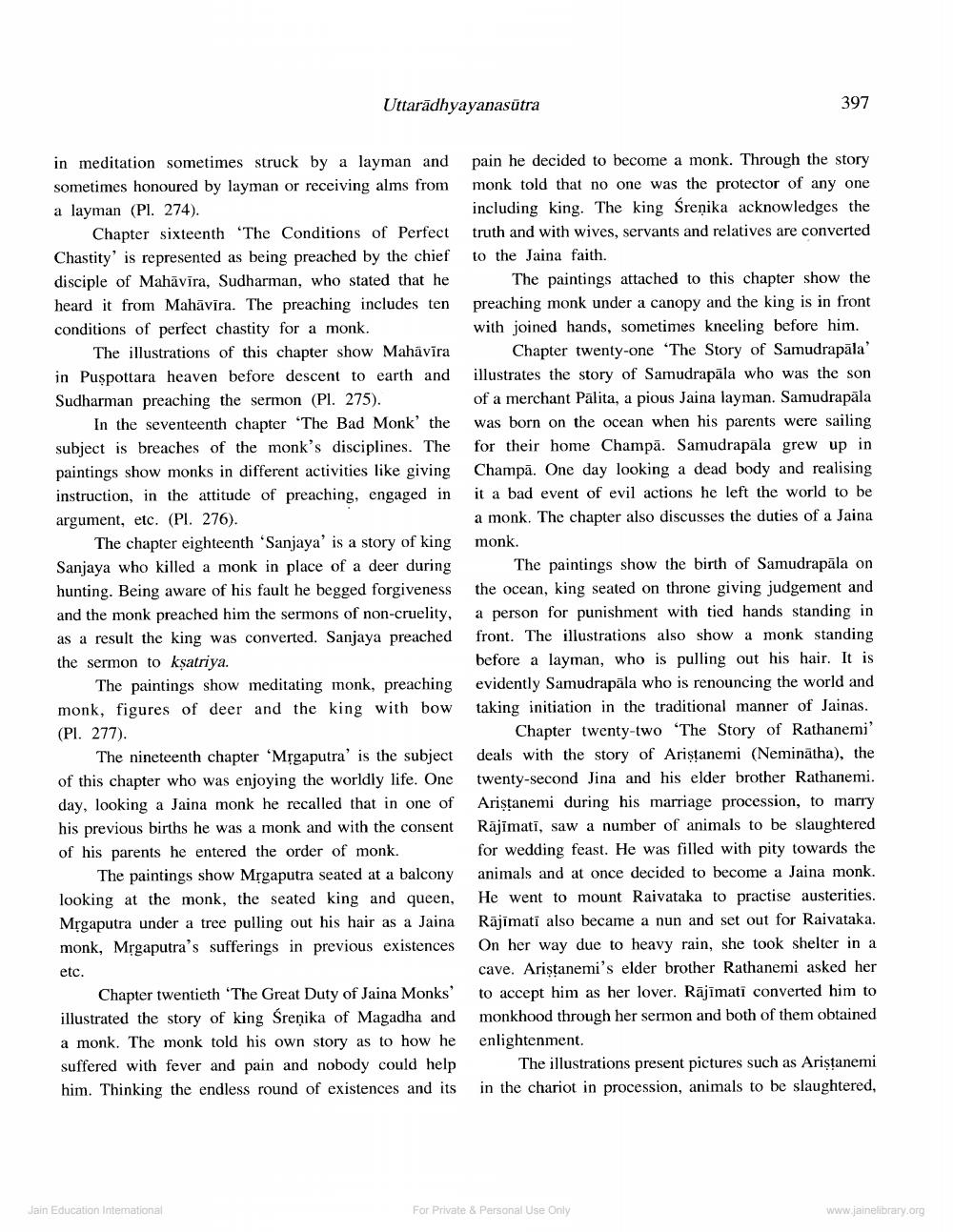________________
Uttarādhyayanasūtra
397
in meditation sometimes struck by a layman and sometimes honoured by layman or receiving alms from a layman (Pl. 274).
Chapter sixteenth "The Conditions of Perfect Chastity' is represented as being preached by the chief disciple of Mahāvīra, Sudharman, who stated that he heard it from Mahāvīra. The preaching includes ten conditions of perfect chastity for a monk.
The illustrations of this chapter show Mahavira in Puspottara heaven before descent to earth and Sudharman preaching the sermon (Pl. 275).
In the seventeenth chapter “The Bad Monk' the subject is breaches of the monk's disciplines. The paintings show monks in different activities like giving instruction, in the attitude of preaching, engaged in argument, etc. (Pl. 276).
The chapter eighteenth 'Sanjaya' is a story of king Sanjaya who killed a monk in place of a deer during hunting. Being aware of his fault he begged forgiveness and the monk preached him the sermons of non-cruelity, as a result the king was converted. Sanjaya preached the sermon to ksatriya.
The paintings show meditating monk, preaching monk, figures of deer and the king with bow (Pl. 277).
The nineteenth chapter 'Mrgaputra' is the subject of this chapter who was enjoying the worldly life. One day, looking a Jaina monk he recalled that in one of his previous births he was a monk and with the consent of his parents he entered the order of monk.
The paintings show Mrgaputra seated at a balcony looking at the monk, the seated king and queen, Mrgaputra under a tree pulling out his hair as a Jaina monk, Mrgaputra's sufferings in previous existences etc.
Chapter twentieth 'The Great Duty of Jaina Monks' illustrated the story of king Śreņika of Magadha and a monk. The monk told his own story as to how he suffered with fever and pain and nobody could help him. Thinking the endless round of existences and its
pain he decided to become a monk. Through the story monk told that no one was the protector of any one including king. The king Sreņika acknowledges the truth and with wives, servants and relatives are converted to the Jaina faith.
The paintings attached to this chapter show the preaching monk under a canopy and the king is in front with joined hands, sometimes kneeling before him.
Chapter twenty-one 'The Story of Samudrapāla' illustrates the story of Samudrapāla who was the son of a merchant Palita, a pious Jaina layman. Samudrapāla was born on the ocean when his parents were sailing for their home Champā. Samudrapala grew up in Champā. One day looking a dead body and realising it a bad event of evil actions he left the world to be a monk. The chapter also discusses the duties of a Jaina monk.
The paintings show the birth of Samudrapāla on the ocean, king seated on throne giving judgement and a person for punishment with tied hands standing in front. The illustrations also show a monk standing before a layman, who is pulling out his hair. It is evidently Samudrapāla who is renouncing the world and taking initiation in the traditional manner of Jainas.
Chapter twenty-two 'The Story of Rathanemi' deals with the story of Aristanemi (Neminātha), the twenty-second Jina and his elder brother Rathanemi. Aristanemi during his marriage procession, to marry Rājīmati, saw a number of animals to be slaughtered for wedding feast. He was filled with pity towards the animals and at once decided to become a Jaina monk. He went to mount Raivataka to practise austerities. Rājīmati also became a nun and set out for Raivataka. On her way due to heavy rain, she took shelter in a cave. Aristanemi's elder brother Rathanemi asked her to accept him as her lover. Rājīmati converted him to monkhood through her sermon and both of them obtained enlightenment.
The illustrations present pictures such as Aristanemi in the chariot in procession, animals to be slaughtered,
Jain Education Intemational
For Private & Personal Use Only
For Private & Personal Use Only
www.jainelibrary.org




